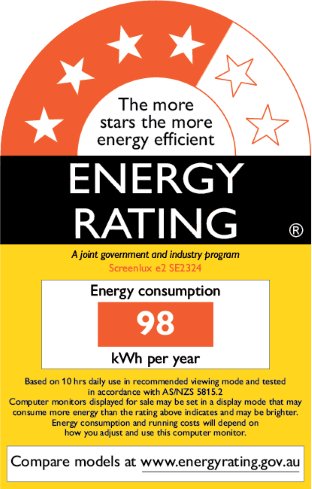For Consumers
Computers and monitors

Computers and monitors
Computers are a vital tool for work, education and entertainment. Like any other electrical appliance, computers and computer monitors have an impact on your energy bill. Choosing the right computer and monitor for your needs and using them efficiently will allow you to minimise the cost and maximise the benefit.
Both computers and monitors must meet mandatory energy efficiency requirements.
- Computers and computer monitors need to meet Minimum Energy Performance Standards.
- Monitors must display an Energy Rating Label, but computers are not required to display a label.

Energy Rating Label for monitors
The more stars, the more savings.
The Energy Rating Label helps you make informed choices when buying a monitor. It provides two important pieces of information about the appliance, the:
- star rating
- estimated energy consumption.
The star rating shows the energy efficiency of the product. It allows you to compare the energy efficiency of products of a similar size. The more stars, the less energy it uses and the cheaper it is to run.
The energy consumption is how much electricity the monitor is estimated to use in a year. This can help you predict the running costs.

Learn more about reading the label and estimating running costs
Visit Understand the Energy Rating LabelHow to choose the right computer monitor for you
-
Start with size
When purchasing a computer monitor, the first step is to determine the size that will best meet your needs.
Size of monitors is usually measured in inches and refers to the diagonal length from the upper left-hand corner of the screen to the lower right-hand corner.
The best size monitor for you will depend on what you will use it for, and the space you have available. For example, detailed tasks such as graphic design or video editing benefit from having a larger display.
It is best to choose the smallest size that meets your needs, as larger screens generally cost more to purchase and cost more to run.
-
Choose your resolution
Determine how detailed you need the images to be.
The resolution of a monitor is the number of pixels that it can display. Higher resolutions provide a much sharper image, but they will require more energy. For most purposes a resolution of 1920×1080 is suitable. However, higher resolutions may be required for gaming or graphic design. 4K monitors are increasing in popularity and offer a resolution of 3840×2160.
-
Match your computer and monitor
Make sure your monitor can connect to your computer and peripherals.
Check your computer to determine the connection required for video output. If you have a newer computer, it is likely that it will have an HDMI port. In this case, you will need to choose a monitor with an HDMI input. If you need to connect to older devices or extra ports for peripherals, make sure to check the monitors you are considering have the connection you need.
-
Use the star rating to compare the energy efficiency of monitors
It is important to compare products of the same size.
Once you have decided on the best size monitor, you can use the star ratings on the Energy Rating Label to compare the energy efficiency of similar sized products.
This is because the star rating considers the size of the monitor. For example, a 32 inch monitor with a five star energy rating will use more energy than a 24 inch monitor with a five star rating.
-
Seek professional advice
Experts can help you make the right choice.
As with any large purchase, it’s a good idea to discuss your options with several suppliers or installers so they can advise on the computer or monitor that is right for you. They will also be able to advise on running costs and where to put the product to improve its energy efficiency.
Additional resources
Want to save on computer and monitor running costs?
View our tips for using computers and monitors efficiently
